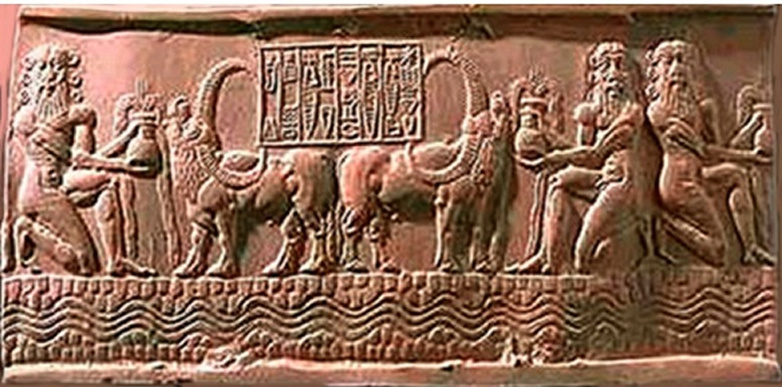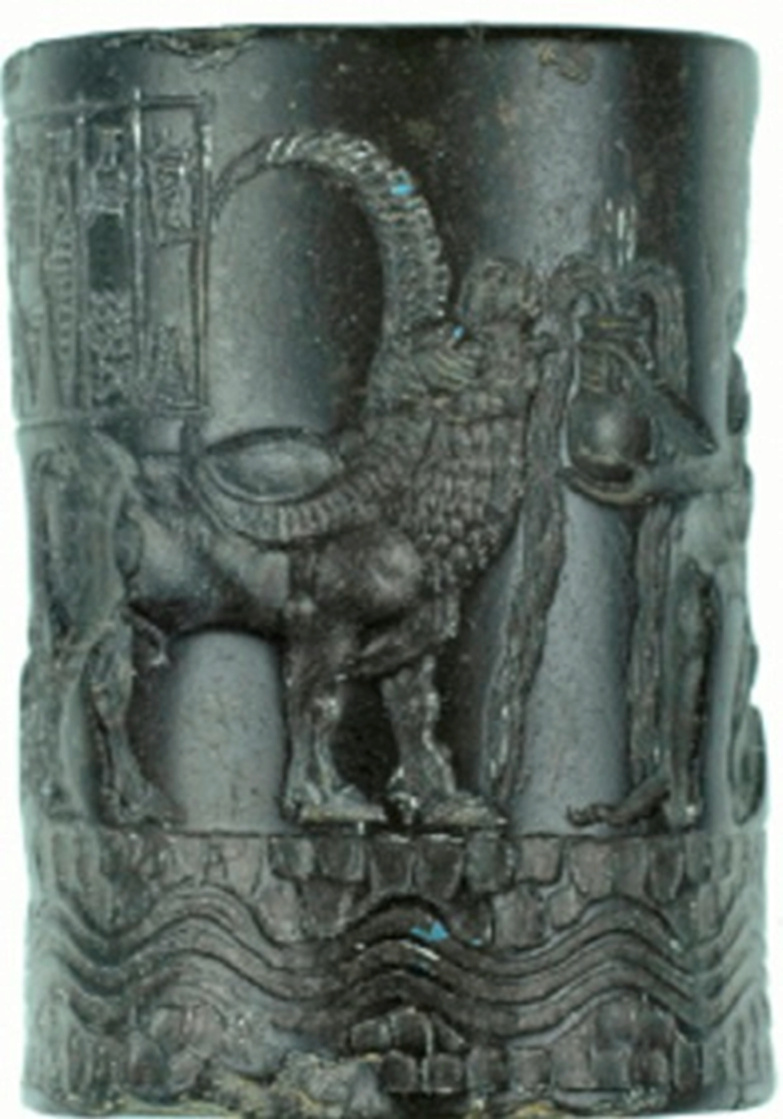Cylinder seal from the reign of the Akkadian king Shar-Kali-Shara (2254 - 2230) BC.

Figure 1: Seal of the scribe of King Ebn-Sharom
The above cylinder seal dates back to the reign of King Shar-Kali-Sharri, whose name means (King of All Kings). He was the fourth son of King Naram-Sin (2291-2254) BC. He ruled ( 25 years old, and his succession was the fifth of the Akkadian kings. He described himself as the builder of (the ikur) (= the house of the god Enlil), and he claimed divinity as an extension of the claim of his father Naram-Sin, as his name was found on a cylinder seal preceded by an asterisk ( ) as evidence of divinity (dingir). The seal, like many other similar seals from the Uruk period, Seals had many important functions, such as: the function of a protective amulet in relation to people or property, authenticating an important written text, sealing contracts such as buying, selling, and adopting, or as an identity mark to identify the sender, whether it is a goods or a message, or to prevent tampering with jars containing oil or Wine or grain, and even a seal on closed doors to ensure that they are not opened. It is often worn in the form of a necklace, pin, or on the wrist. In general, this seal is an impressive example in terms of precise engraving and exquisite art, and makes it one of the masterpieces of decorative art that characterized the Akkadian era. It is known that cylinder seals appeared at the end of the Uruk period, around 3500-3100 BC. It began to be used to seal the first written documents from that era until now, but currently the signature or fingerprint is used instead of seals.

Figure 2: Chlorite stone seal
The cylindrical seal was made of chlorite stone (chlorite stone is a silicate mineral that is green in color and is found in igneous, metamorphic, and sedimentary rocks). It dates back to the reign of King Shar-Kali-Shara. The size of the seal in terms of height is (3 cm and 9 mm), Its diameter (two centimeters and six millimeters) is engraved with a scene of two naked heroes without a horned hat to indicate that they are gods. They are half kneeling in a symmetrical manner, and both of them carry a jar from which water flows as a symbol of fertility and abundance. It also represents the character of the river god Enki/Ea. They are considered the spirits of flowing water, and perhaps the two naked heroes are helpers in continuing the flow of water. In the middle are two water buffalo animals quenching their thirst from the water of the two jars. Under the scene we see a river flowing between the mountains represented in the form of two lines as if they were rocks on both banks of the river, and there is a painting in the center of the seal. Between the horns of the buffalo bears an inscription in cuneiform writing: (God Shar-Kali-Sharum, King of Akkad, Ibni-Sharum, the scribe, his servant). The seal belongs to the scribe Ibni-Sharrum, the scribe of King Shar-Kali-Sharum, and this seal is considered It is one of the most prominent examples of the perfection achieved by sculptors in the period of Akkadian rule. Many seals were found in different eras, whether for scribes of kings, or workers in the palace, or merchants, or eunuchs (Sa-Rish), or subordinate rulers, all of which bear the name of the king and the name of The owner of the seal, as shown in the seal above, Naturally, we infer from these seals our knowledge of the rule of kings and employees during their rule.
As for buffaloes, they are symbolic animals in Akkadian art. They appeared for the first time during the reign of Sargon, which indicates the existence of continuing relations between the Akkadian Empire and the distant region of Meluha (Meluḫḫa), i.e. the current Indus Valley (Pakistan). There are some seals that dealt with topics from the Indus Valley, namely It is clearly visible in the Near Eastern Antiquities Collections section of the Louvre Museum in Paris, such as a seal bearing the inscription of a crocodile and another bearing the shape of a hippopotamus. Both animals did not exist in ancient Iraq. Likewise, the water buffalo originated from there. Perhaps these strange creatures were kept at that time in zoos. It does not seem to have been adapted to Iraq at the end of the third millennium BC, and it did not appear on seals even during the era of the Sasanian Empire (539) BC. The engraving on the seal highlighted, with great care, the strong muscles of the buffalo and the long horns raised to the top. This seal is an example of the style of the late Akkadian period. Seals of this type were reserved for the entourage of the royal family or dignitaries, and they may have been made in a special workshop that was reserved. Production for this elite.
Source: websites

